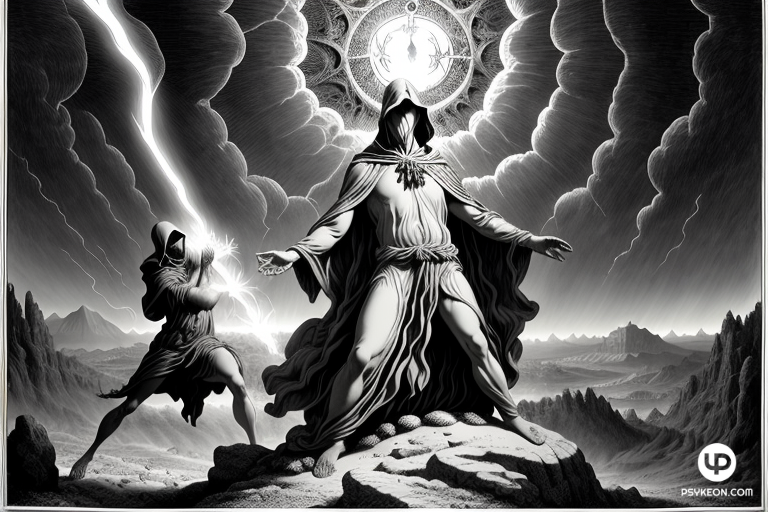Today is Ash Wednesday in most Christian denominations, marking the first day of Lent, the 40 day period of prayer, penance and almsgiving leading to Easter.
I always ascribe two self-supporting meanings to Lent: It is a time of introspection and self-analysis, and a time of letting go of attachments, not just to pleasure (temptations), but to whatever is holding us back from reaching our material and transcendental ideals (distractions).
In fact, Lent and Easter are my favorite Christian traditions, first because they coincide with the arrival of Spring, but also because they allow me to put in perspective and bring some balance to the many esoteric and psychonautic practices that make up the majority of my spiritual journey.
“When you get the message, hang up the phone,” said Alan Watts.
Reflect and review.
Discern.
Integrate.
The timeless archetypes of tarot cards can provide us with important reminders and inspiration in this often uncomfortable but freeing process.
Whereas adherents to scientism usually view divination practices (including tarot cards) as mere superstitions or charlatanism, the Catholic Church usually sees them as a dishonest treason towards the will of God, potentially leading to idolatry and other sins. As such, I recommend using tarot cards, not as a divinatory tool, but as an introspective and projective archetypal guide akin to the Christian practice of Visio Divina (prayer using images), which limits potential conflicts with Christian beliefs as well as modern science and psychology.
In this context, some meaningful tarot cards to support your meditations and introspection during Lent include:
- The Hermit
- The Devil
- Temperance
- The Hanged Man
- Death
The Hermit card represents the overarching essence of this period of introspection and solitude, mirroring Jesus’ forty days of fasting, temptation and prayer. Like the Hermit, we withdraw from and ignore the temptations and distractions of the world to focus on our relationship with what truly matters. From the void comes insight and wisdom. Look inward with honesty, spend time studying, and review your journey regularly. Connect with those you love, and give of yourself to humanity. Ask yourself: “What areas of my life need more attention and nurturing?”
In the desert, Jesus faced temptation from the Devil, just as we confront our own attachments and distractions during Lent. The Devil card confronts us to the uncomfortable reality that temptations and distractions will always exist around us. Be honest with yourself when you encounter him: look the Devil right in the eyes as you consciously do what is truly meaningful. He serves as a warning and reminder to resist the allure of distractions and temptations and stay true to your path and ideals. Write down the things in your life that consistently pull you away from your path. What steps can you take during Lent to stay true to yourself and your path in the face of these temptations?
The Temperance that we cultivate each and every moment of Lent guides us in finding balance and harmony in our journey. Just as Jesus endured suffering and temptation in the desert, Temperance teaches us to endure trials with patience and grace. It reminds us that through moderation and balance, we find spiritual harmony and inner peace. Reflect on a recent situation where you felt a lack of balance or moderation. How did this imbalance impact your thoughts, actions, and relationships? What lessons can you learn from this experience, and how can you apply them to cultivate greater harmony and moderation in your life during and after Lent?
As Jesus surrendered to God’s will in the desert, so too do we learn the art of letting go and surrendering during Lent. Upside down like Odin, The Hanged Man card symbolizes the act of relinquishing control and trusting the journey. Taking a new, more acceptance and trusting perspective towards discomfort. This is not always pleasant, but it is necessary and meaningful, as it is through surrender that we open ourselves to insights, transformation and growth. Repeat the mantra “I surrender to the journey” for 2 minutes as you look at the card.
The journey of Lent culminates in the ultimate transition: Jesus’ death on the cross. The Death card represents this profound change and transition, reminding us of the sacrifice Jesus made for humanity’s salvation. Lent calls us to confront our own vulnerabilities and embrace the transformative power of sacrifice, change, and eventual resurrection. Write down any habits, attitudes, or behaviors that no longer serve your spiritual growth. Make a simple plan of how you could improve them after Lent.
Let the cards guide you on this journey of introspection and surrender.
Safe travels



